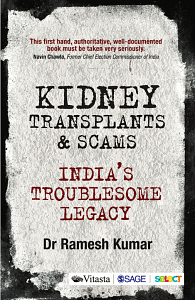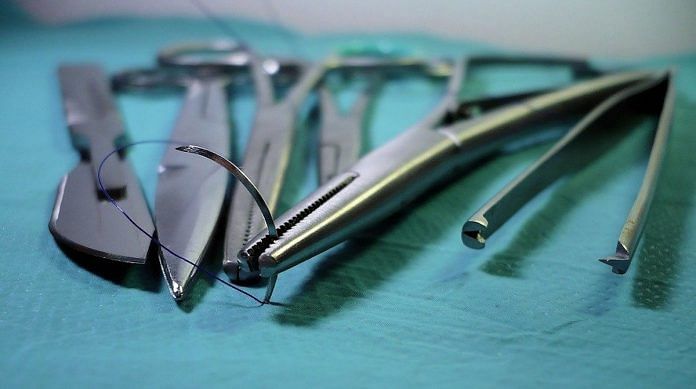It did not take long for the city of Mumbai to turn into the biggest centre of organ trade in the country as the city had several competent hospitals offering transplant services.
One senior nephrologist at Bombay Hospital, in an article for India Today, wrote in 1990, ‘we are burying our heads in the sand’.
‘What does one do when there are no organs forthcoming from cadavers? Do I turn my patient away and say prepare for your death? As long as it is properly regulated there is nothing wrong with organ transplants.’
At the same time, some hospitals employed an ill-conceived approach to try to break the grip of middlemen by starting to advertise for kidneys themselves. A new term was coined – reward gifting. Here, unrelated donors completed paperwork including affidavits attesting ‘deep love and affection’ for the patient.
This led to a storm of counter-arguments from much of the medical fraternity and hospitals that had already stopped transplantation from unrelated kidney donors. This resulted in an ‘illegal’ trade that quickly spread to private nursing homes in the suburbs of Mumbai and neighbouring cities like Pune.
Also read: ‘Mastermind’ of Kanpur kidney racket, 2 others were busted for same crime in 2016
Surgeries were often performed in temporary clinics without licenses and there were many reports of serious post-operative complications in ill-equipped nursing homes, where at least a few donors lost their lives. There was no check on pre-operative screening of hepatitis-B or HIV among donors, and subsequent complications were largely ignored and forgotten. The police and Maharashtra State Medical Council struggled to put an end to the problem.
Mumbai became a preferred destination for patients seeking paid kidney donors, particularly among Arab countries. Proximity to India’s west coast was not the only reason. At that time, Mumbai was India’s richest city, its commercial hub.
These wealthy Arab patients would get admitted in well-known hospitals such as Breach Candy Hospital and Jaslok Hospital, get dialysis done there. They then received transplantation in private nursing homes. After the transplant, the recipient returned to these hospitals for the post-operative care and treatment. Such patients would stay in hospitals for months, get well, and entire families would come for medical checkups and shopping.
Hospitals provided up-to-date medical care and earned large amounts of money through this trade of transplantation. The doctors and nursing homes made their money without any responsibility of aftercare. In this game of misuse and exploitation, the donor was paid a pittance and shunted out with no mercy from anybody.
It was estimated that in the early ’90s, kidney trade had a turnover of Rs 40 crore in Mumbai alone. Soon Bombay had worldwide attention and became a dubious city where kidneys were treated as a marketable commodity.
Also read: Top Indian hospitals, foreign clients, donors from UP caught in ‘kidney transplant racket’
The role of city laboratories was thoroughly inter-mixed, and there were several instances of tampering of reports by middlemen. The concerned doctors too were to be blamed. They were not concerned with rechecking vital reports of the donors before accepting them as a ‘related’ or ‘an altruistic unrelated’ donor. Of course, soon the relationship between donor and doctor became totally commercial.
At this juncture came a warning from the International Transplantation Society. It said, ‘no doctor shall be involved directly or indirectly in buying or selling of organs for any transplantation activity aimed at commercial gain’. The society warned that any doctor found engaged in commercial organ trade ‘will stand expulsion’.
It was an India that had given up all ethics and scientific norms by that time and only money mattered. The country was going through a political crisis, and unstable governments by purchasable legislators were in and out of power. There was acute financial crisis too for the Indian economy and the much-touted Narasimha Rao government’s reforms were still to show some effect. The International Transplantation Society’s warning had no impact on the kidney trade whatsoever. Despite this warning, the roaring business of brokers, doctors and hospitals continued in Mumbai, and the kidney was the hottest marketable commodity sold anywhere between Rs 30,000 to 50,000 apiece.
The indigent donor was in desperate need of hard cash, and there was always a rich buyer available with the help of a broker, sub-broker, doctors and hospitals. Even senior doctors needing such transplants had no qualms about ‘purchasing’ kidneys for themselves.
It also became a prevalent practice of random donors writing letters to practicing nephrologists, transplant surgeons and even hospitals directly to sell their kidney and bypass the brokerage and harassment by brokers.
Also read: How I led the team that carried out India’s first hand transplant
Attempt to Legislate
Having realised the potential of such transplants an attempt was made to formulate and legislate the use of cadaver kidneys for the first time in India in the State of Maharashtra to which Bombay/Mumbai belongs. This law was called the ‘Maharashtra Kidney Transplantation Act of 1982’. It was enacted by the Maharashtra Assembly in December 1982.
However, it became impossible to implement the same in view of the absence of ‘Brain Stem death’ criteria in this law. This needed a specific set of rules to be made for the purpose.
Meanwhile, as the problem of inadequate availability of donors from amongst the family members was mounting, some clinicians started using kidneys from ‘unrelated’ donors for transplants.
The 1982 Maharashtra Kidney Act for cadaver transplantation had no jurisdiction on the trade of kidneys from ‘live donors’ and so the lucrative enterprise by donors and their agents continued unabated.
Feeble attempts at making a difference by the Maharashtra Medical Council and Life Foundation were largely ineffective.
So dangerous was the game that makeshift transplant centres sprouted in converted apartments where patients were exposed to life-threatening infections.
Many West Asian patients – who underwent living unrelated kidney transplants in India – returned to their countries with bacterial and viral infections. There was a high mortality rate among recipients and donors with inadequate care, and commercial interest was paramount from beginning to end. The average cost of kidney and medical services in the 1990s was about Rs 1.75 lakh. About Rs 40,000 to 50,000 was paid to the donors who came from the slums and footpaths of Mumbai, the commercial capital of India. There were reports of missing persons who were kidnapped, and their kidneys removed to earn huge money.
At this juncture, strong opinions were expressed regarding the legal aspects of this unholy kidney bazaar in Mumbai. At that time, a senior advocate had been reported to have said, ‘if my own relative needs treatment, I will not open the Indian Penal Code to examine the legality but open my wallet and save the patient (Indian Express, 8.7.1989)’.
Thus, Suketu Mehta’s Maximum City acquired the dubious distinction of being the easiest and cheapest market for kidney trade, which continued to hold this status for many years.
Media started focusing on Mumbai in the late eighties. Rich Indians took their kidney donors from the slums of Mumbai to London for a transplantation and the donor was allegedly paid between 2000 to 4000 pounds. As this became known, the print media worked over-time in England to highlight this exploitative practice by patients who took organs from the impoverished of Mumbai.
The ‘scandal of the wealthy’ flourished with handsome dividends for surgeons and pittance to the poor. In Bombay’s great kidney bazaar, well- protected networks between middlemen (dalal), laboratories, surgeons and nursing homes/hospitals were in place and a kidney transplant was possible within a week or so.
To make matters worse, the medical fraternity made statements in favour of buying kidneys for transplantation, and the print media highlighted such statement without any sense of responsibility on both sides. The practice was so rampant that by the ’90s, nearly 100 transplants per month were being done in Bombay alone with a billion rupee/ year industry in India. The real beneficiaries were the doctors, agents, hospitals and the poor, gullible donors were left behind.
Mumbai has the largest number of kidney transplant centres in the country today.
 This excerpt from Kidney Transplants and Scams: India’s Troublesome Legacy by Ramesh Kumar, Chief Nephrologist, Moolchand Hospital Delhi, has been published with permission from Vitasta SAGE Select.
This excerpt from Kidney Transplants and Scams: India’s Troublesome Legacy by Ramesh Kumar, Chief Nephrologist, Moolchand Hospital Delhi, has been published with permission from Vitasta SAGE Select.




Are you in debt? Do you want to sell your kldney for money? WhatsApp us now on +918651938235.
Are you in debt? Do you want to sell your kldney for money to solve your financial problem? WhatsApp us now on +918651938235.
I also cheated from dr.abraham sandip ,lilavati hospital.take ragistation fee 3600rs.and now dr jenifor associated doctor asking to pay 19000 for release consignment ,custom duty.please beware above said doctor.
This is Manny problem and family problam
All fake
My name Raghavendra cheet me to hospitals name take Fortis and Apolo 70000ru pls don’t believe also chitters
Also cheeters don’t believe
All are fake they first told to paid registration fee after say to paid income tax than we send half ammount in your account
It’s urgent